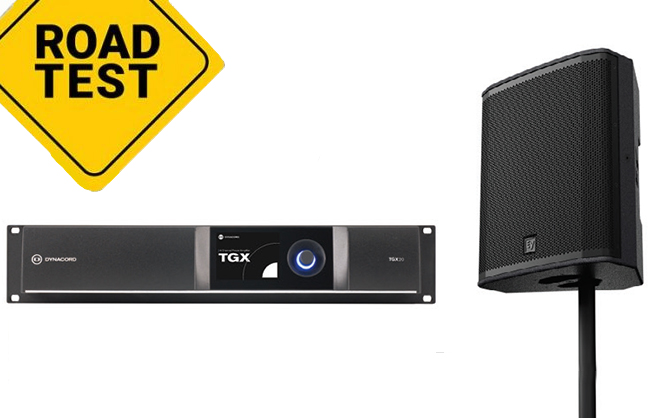
Working In Tandem
MFX loudspeakers are optimized for use with both the TGX (for live) and IPX (for install) series amplifiers from Dynacord. Two TGX models are offered (TGX10 and TGX20), and they’re also available in a preconfigured system rack including three TGX20s, power distribution, input and output interfaces and network redundancy.
The TGX20 is an impressive piece of hardware. It’s a four-channel amplifier with fully integrated DSP running at 96 kHz with proprietary FIR (Finite Impulse Response) Drive technology, configurable via the SONICUE control software over a network, or alternatively the front-panel touchscreen, which I found intuitive and responsive.
The TGX20 has a stated IHFA-202 burst power rating of 5000 W / channel at 4 ohms with all channels driven, and a voltage gain adjustable between 24 and 40 dB, corresponding to an input sensitivity of 5.7 to 21.7 dBu. Inputs can come via analog, AES3, or Dante, with configurable failover and input trim to match levels between sources.

At the time the rig showed up, my plan was to use it for an upcoming gig with an AC/DC tribute act that required loud wedges, and I was very much looking forward to turning the monitor engineer loose with this rig, but alas it was not to be. However, I did set the rig up in my shop and after some listening and testing, found these wedges to be a significant improvement over the models we currently deploy for such events.
I employed the Meyer Sound M-Noise procedure to document sound pressure levels. The MFX-12MC, using the corresponding preset in the TGX20 amplifier, cleanly produced 115 dB SPL C Slow Max and 130 dB Peak C before the preset limiter kicked in.
Further bench testing revealed that the presets (more on those in a bit) do a nice job of presenting a nominally flat frequency response – and more importantly, matched both models. Usually, when I have multiple wedge models on stage, time needs to be spent making sure they all sound reasonably similar, and in this case they matched very well, which I certainly appreciate. In monitor position, I found the HF coverage to be quite even throughout the 40- x 60-degree (h x v) coverage pattern due to the coaxial configuration.
Through Its Paces
SONICUE is one of the most intuitive and easy to use software platforms that I’ve encountered for networked DSP amplifiers. I was able to quickly connect to the amp and load the desired presets for each channel, set my input and output routing, and establish my desired gain structure, all without consulting documentation.
I particularly like the EQ interface (which offers a nice variety of filter topologies including notch and asymmetric) and the load monitoring feature. For each of the loudspeakers, there’s a choice of full-range FOH or monitor presets – the former employing FIR filters that achieved a nominally flat phase response above 250 Hz and the latter employing minimum phase filtering for latency-critical monitoring applications. (I measured the amp’s throughput latency at 0.73 milliseconds when using monitor presets and analog inputs, with the linear-phase FIR filters for FOH applications clocking in around 6 ms).

Both the FOH and monitor presets come in passive and bi-amped versions, as well as 80 Hz high-passed versions of each as well, with additional time alignment in place to align with a companion subwoofer, according to the applications engineering team at EV.
The 1 kHz crossover region, a problematic area for many coaxial boxes, is well-behaved here, even when running in passive mode. Thanks to the well-behaved magnitude and phase response, they maintain a pleasing clarity and a satisfying amount of stability against feedback.
The rig as a whole is, in my opinion, extremely well suited to getting quickly set up and rolling, with intuitive yet powerful DSP control software and very functional “out of the box” tunings, which I would feel comfortable mixing on without having to do a bunch of additional “taste” tuning. Overall, MFX multi-function loudspeakers and TGX amplifiers form a very effective and capable monitor system that I would be happy to encounter in a professional setting.
U.S. MSRP – MFX-15MC: $2,652; MFX-12MC: $2,346; Dynacord TGX20: $12,230
Go here to find out more about the Electro-Voice MFX Series and here for more about the Dynacord TGX Series.
